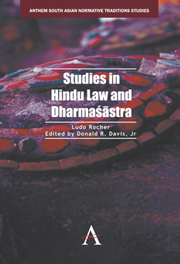Book contents
- Frontmatter
- Contents
- Foreword by Richard W. Lariviere
- Preface
- Abbreviations
- Note on the Edition
- Introduction
- PART ONE THE NATURE OF HINDU LAW
- PART TWO GENERAL TOPICS OF HINDU LAW
- PART THREE HINDU LEGAL PROCEDURE
- PART FOUR TECHNICAL STUDIES OF HINDU LAW
- PART FIVE ANGLO-HINDU AND CUSTOMARY LAW
- Indian Response to Anglo-Hindu Law
- Can a Murderer Inherit his Victim's Estate? British Responses to Troublesome Questions in Hindu Law
- Reinterpreting Texts: When Revealed Sanskrit Texts Become Modern Law Books
- Father Bouchet's Letter on the Administration of Hindu Law
- Jacob Mossel's Treatise on the Customary Laws of the Veḷḷāla Cheṭṭiyārs
- Bibliography
- Index
Reinterpreting Texts: When Revealed Sanskrit Texts Become Modern Law Books
from PART FIVE - ANGLO-HINDU AND CUSTOMARY LAW
Published online by Cambridge University Press: 05 February 2013
- Frontmatter
- Contents
- Foreword by Richard W. Lariviere
- Preface
- Abbreviations
- Note on the Edition
- Introduction
- PART ONE THE NATURE OF HINDU LAW
- PART TWO GENERAL TOPICS OF HINDU LAW
- PART THREE HINDU LEGAL PROCEDURE
- PART FOUR TECHNICAL STUDIES OF HINDU LAW
- PART FIVE ANGLO-HINDU AND CUSTOMARY LAW
- Indian Response to Anglo-Hindu Law
- Can a Murderer Inherit his Victim's Estate? British Responses to Troublesome Questions in Hindu Law
- Reinterpreting Texts: When Revealed Sanskrit Texts Become Modern Law Books
- Father Bouchet's Letter on the Administration of Hindu Law
- Jacob Mossel's Treatise on the Customary Laws of the Veḷḷāla Cheṭṭiyārs
- Bibliography
- Index
Summary
In 1772, the British East India Company appointed a new governor of Bengal, Warren Hastings, “one of the most remarkable figures in India's history” (see Frykenberg 1988: 38). Hastings did not wait long to promote the adoption of a juridical plan that was to become one of his major legacies on the Indian subcontinent. According to the plan, “in all religious suits regarding inheritance, marriage, caste and all other religious usages and institutions, the laws of the Koran with respect to the Mohamedans and those of the Shaster with respect to the Gentoos shall invariably be adhered to.” In other words, in 1772 the British authorities in Calcutta decided that Indian Hindus and Indian Muslims should not be ruled by British laws, which they would not be able to understand, but by their own laws, which they had cherished for many centuries. In this essay, I will not deal with the Indian Muslims, who, according to the plan, were to be governed by the laws of the Koran. I will restrict myself to the Hindus, who were to be ruled by the laws of “the Shaster.”
The term “Shaster,” used in the judicial plan of 1772, corresponds to the Sanskrit term śāstra, which is the collective name for the voluminous body of Sanskrit texts (the śāstra and their commentaries) dealing with the Hindu dharma. The term dharma has no appropriate English equivalent; it refers to the aggregate of all the rules by which a Hindu must live, including rules that we would label rules of law.
- Type
- Chapter
- Information
- Studies in Hindu Law and Dharmasastra , pp. 661 - 672Publisher: Anthem PressPrint publication year: 2012



